Complications and Surveillance after Bariatric Surgery
VerifiedAdded on 2021/04/17
|9
|2622
|66
AI Summary
This assignment details various complications and surveillance measures associated with bariatric surgery. It includes references to research studies on obesity-related health issues, surgical team composition, and postoperative care. The documents provided cover topics such as Cushing's syndrome, hypertension, and respiratory complications in obese patients.
Contribute Materials
Your contribution can guide someone’s learning journey. Share your
documents today.
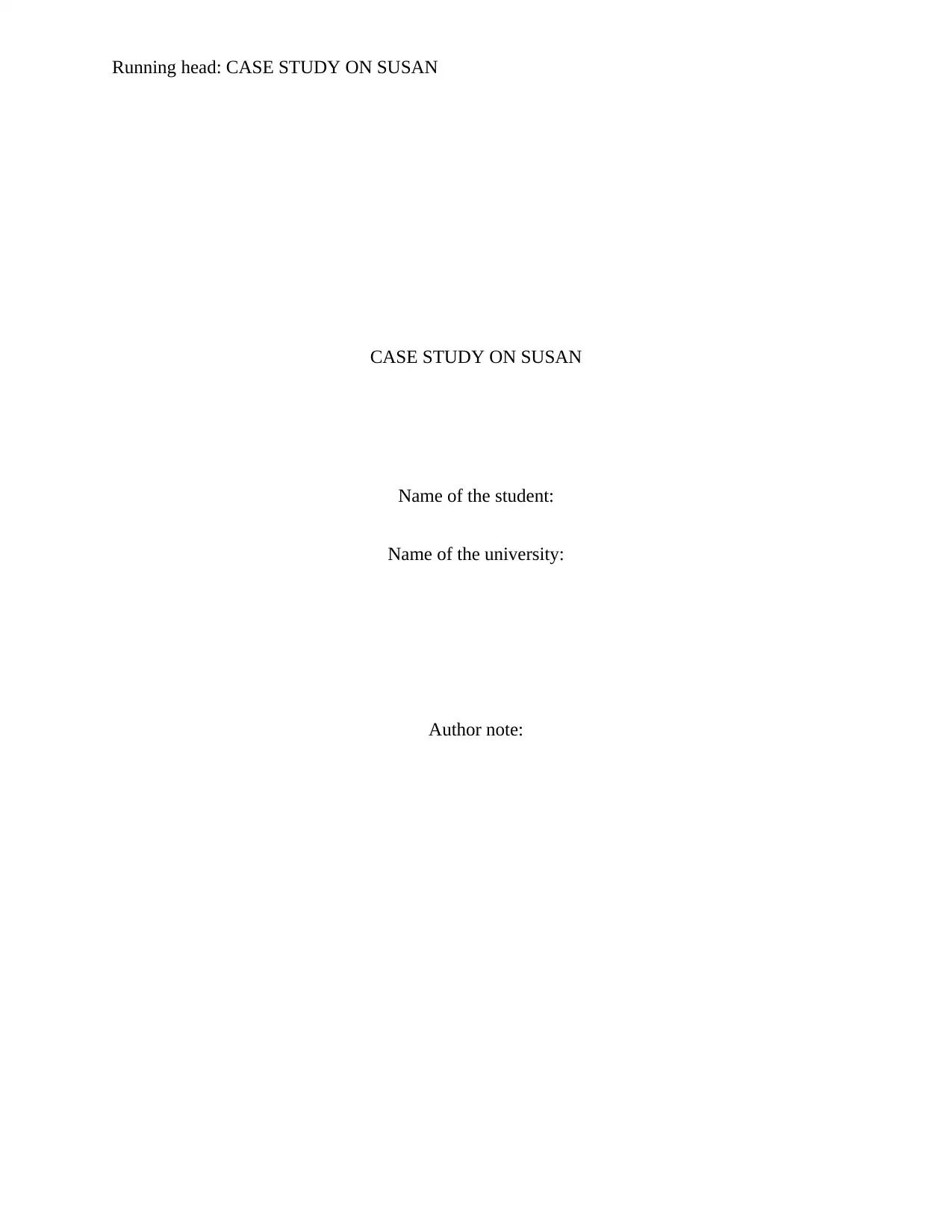
Running head: CASE STUDY ON SUSAN
CASE STUDY ON SUSAN
Name of the student:
Name of the university:
Author note:
CASE STUDY ON SUSAN
Name of the student:
Name of the university:
Author note:
Secure Best Marks with AI Grader
Need help grading? Try our AI Grader for instant feedback on your assignments.

1
CASE STUDY ON SUSAN
Cushing syndrome takes place when individuals are exposed to prolonged periods of
elevated levels of either exogenous or endogenous glucocorticoids. It is mainly seen that
individuals develop Cushing syndrome when they have abnormally high level of the cortisol
hormones due to a variety of reasons. The healthcare professionals can identify a number of
symptoms that help them in identifying the disorder of the individuals besides finding the level
of cortisol in the blood tests. Such symptoms usually include weight gain of the individuals,
increased obesity, fat deposition mainly in the midsection of the face resulting in casing a round
and moon-shaped face (Nieman et al., 2015). The fat is also deposited in between the shoulders
as well as in the upper back showing a humped structure like buffalo. Purple stretch marks also
occur on the breasts, arms, abdomen as well as thighs of the individuals. Tinning of the skin
resulting in bruises is also seen in such individuals. Moreover, acne, fatigue, skin injuries (which
heal slowly) all help professionals to identify the disorder. In the assignment, a patient named
Susan, had been admitted to the ward for treatment of her Cushing syndrome. The etiology and
pathophysiology of the disorder would be discussed which would be then followed by
identifying the rationale of her degrading health condition after the laproscopic surgery. The
important members of the multidisciplinary teams members would be also discussed who would
take active participation in her treatment and care plan.
Researchers are of the opinion that Cushing syndrome may occur due to medication as
well as by tumors. In many cases, tumors are present on the adrenal gland which results in the
making of a large amount of cortisol. In other cases, such symptoms may also occur when
tumors are formed in the pituitary gland that is responsible for production of different hormones
in the body. Some of the pituitary gland tumors are responsible for production of huge amount of
adrenocorticoptrophic hormone called the ACTH. This hormone in turn cases the stimulation of
CASE STUDY ON SUSAN
Cushing syndrome takes place when individuals are exposed to prolonged periods of
elevated levels of either exogenous or endogenous glucocorticoids. It is mainly seen that
individuals develop Cushing syndrome when they have abnormally high level of the cortisol
hormones due to a variety of reasons. The healthcare professionals can identify a number of
symptoms that help them in identifying the disorder of the individuals besides finding the level
of cortisol in the blood tests. Such symptoms usually include weight gain of the individuals,
increased obesity, fat deposition mainly in the midsection of the face resulting in casing a round
and moon-shaped face (Nieman et al., 2015). The fat is also deposited in between the shoulders
as well as in the upper back showing a humped structure like buffalo. Purple stretch marks also
occur on the breasts, arms, abdomen as well as thighs of the individuals. Tinning of the skin
resulting in bruises is also seen in such individuals. Moreover, acne, fatigue, skin injuries (which
heal slowly) all help professionals to identify the disorder. In the assignment, a patient named
Susan, had been admitted to the ward for treatment of her Cushing syndrome. The etiology and
pathophysiology of the disorder would be discussed which would be then followed by
identifying the rationale of her degrading health condition after the laproscopic surgery. The
important members of the multidisciplinary teams members would be also discussed who would
take active participation in her treatment and care plan.
Researchers are of the opinion that Cushing syndrome may occur due to medication as
well as by tumors. In many cases, tumors are present on the adrenal gland which results in the
making of a large amount of cortisol. In other cases, such symptoms may also occur when
tumors are formed in the pituitary gland that is responsible for production of different hormones
in the body. Some of the pituitary gland tumors are responsible for production of huge amount of
adrenocorticoptrophic hormone called the ACTH. This hormone in turn cases the stimulation of
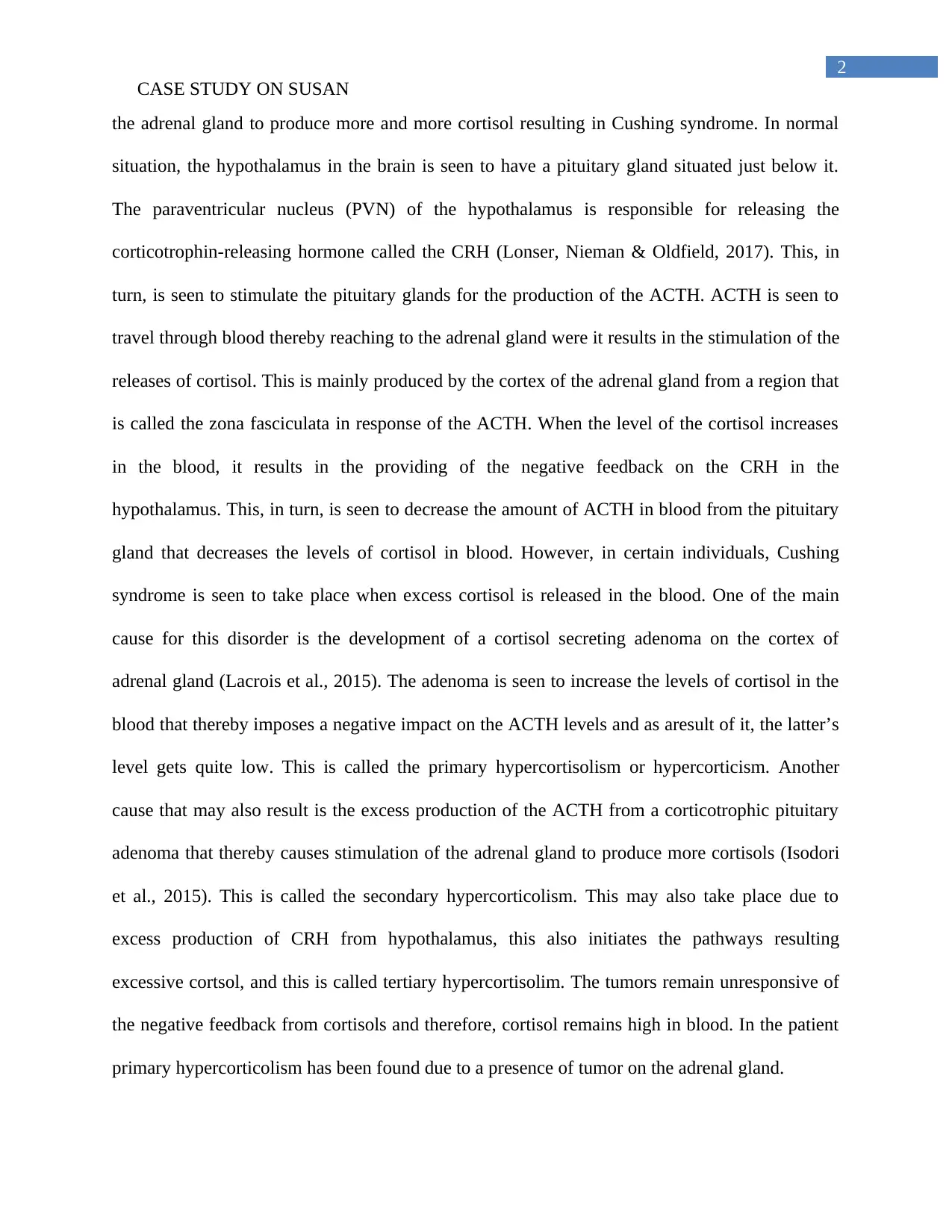
2
CASE STUDY ON SUSAN
the adrenal gland to produce more and more cortisol resulting in Cushing syndrome. In normal
situation, the hypothalamus in the brain is seen to have a pituitary gland situated just below it.
The paraventricular nucleus (PVN) of the hypothalamus is responsible for releasing the
corticotrophin-releasing hormone called the CRH (Lonser, Nieman & Oldfield, 2017). This, in
turn, is seen to stimulate the pituitary glands for the production of the ACTH. ACTH is seen to
travel through blood thereby reaching to the adrenal gland were it results in the stimulation of the
releases of cortisol. This is mainly produced by the cortex of the adrenal gland from a region that
is called the zona fasciculata in response of the ACTH. When the level of the cortisol increases
in the blood, it results in the providing of the negative feedback on the CRH in the
hypothalamus. This, in turn, is seen to decrease the amount of ACTH in blood from the pituitary
gland that decreases the levels of cortisol in blood. However, in certain individuals, Cushing
syndrome is seen to take place when excess cortisol is released in the blood. One of the main
cause for this disorder is the development of a cortisol secreting adenoma on the cortex of
adrenal gland (Lacrois et al., 2015). The adenoma is seen to increase the levels of cortisol in the
blood that thereby imposes a negative impact on the ACTH levels and as aresult of it, the latter’s
level gets quite low. This is called the primary hypercortisolism or hypercorticism. Another
cause that may also result is the excess production of the ACTH from a corticotrophic pituitary
adenoma that thereby causes stimulation of the adrenal gland to produce more cortisols (Isodori
et al., 2015). This is called the secondary hypercorticolism. This may also take place due to
excess production of CRH from hypothalamus, this also initiates the pathways resulting
excessive cortsol, and this is called tertiary hypercortisolim. The tumors remain unresponsive of
the negative feedback from cortisols and therefore, cortisol remains high in blood. In the patient
primary hypercorticolism has been found due to a presence of tumor on the adrenal gland.
CASE STUDY ON SUSAN
the adrenal gland to produce more and more cortisol resulting in Cushing syndrome. In normal
situation, the hypothalamus in the brain is seen to have a pituitary gland situated just below it.
The paraventricular nucleus (PVN) of the hypothalamus is responsible for releasing the
corticotrophin-releasing hormone called the CRH (Lonser, Nieman & Oldfield, 2017). This, in
turn, is seen to stimulate the pituitary glands for the production of the ACTH. ACTH is seen to
travel through blood thereby reaching to the adrenal gland were it results in the stimulation of the
releases of cortisol. This is mainly produced by the cortex of the adrenal gland from a region that
is called the zona fasciculata in response of the ACTH. When the level of the cortisol increases
in the blood, it results in the providing of the negative feedback on the CRH in the
hypothalamus. This, in turn, is seen to decrease the amount of ACTH in blood from the pituitary
gland that decreases the levels of cortisol in blood. However, in certain individuals, Cushing
syndrome is seen to take place when excess cortisol is released in the blood. One of the main
cause for this disorder is the development of a cortisol secreting adenoma on the cortex of
adrenal gland (Lacrois et al., 2015). The adenoma is seen to increase the levels of cortisol in the
blood that thereby imposes a negative impact on the ACTH levels and as aresult of it, the latter’s
level gets quite low. This is called the primary hypercortisolism or hypercorticism. Another
cause that may also result is the excess production of the ACTH from a corticotrophic pituitary
adenoma that thereby causes stimulation of the adrenal gland to produce more cortisols (Isodori
et al., 2015). This is called the secondary hypercorticolism. This may also take place due to
excess production of CRH from hypothalamus, this also initiates the pathways resulting
excessive cortsol, and this is called tertiary hypercortisolim. The tumors remain unresponsive of
the negative feedback from cortisols and therefore, cortisol remains high in blood. In the patient
primary hypercorticolism has been found due to a presence of tumor on the adrenal gland.
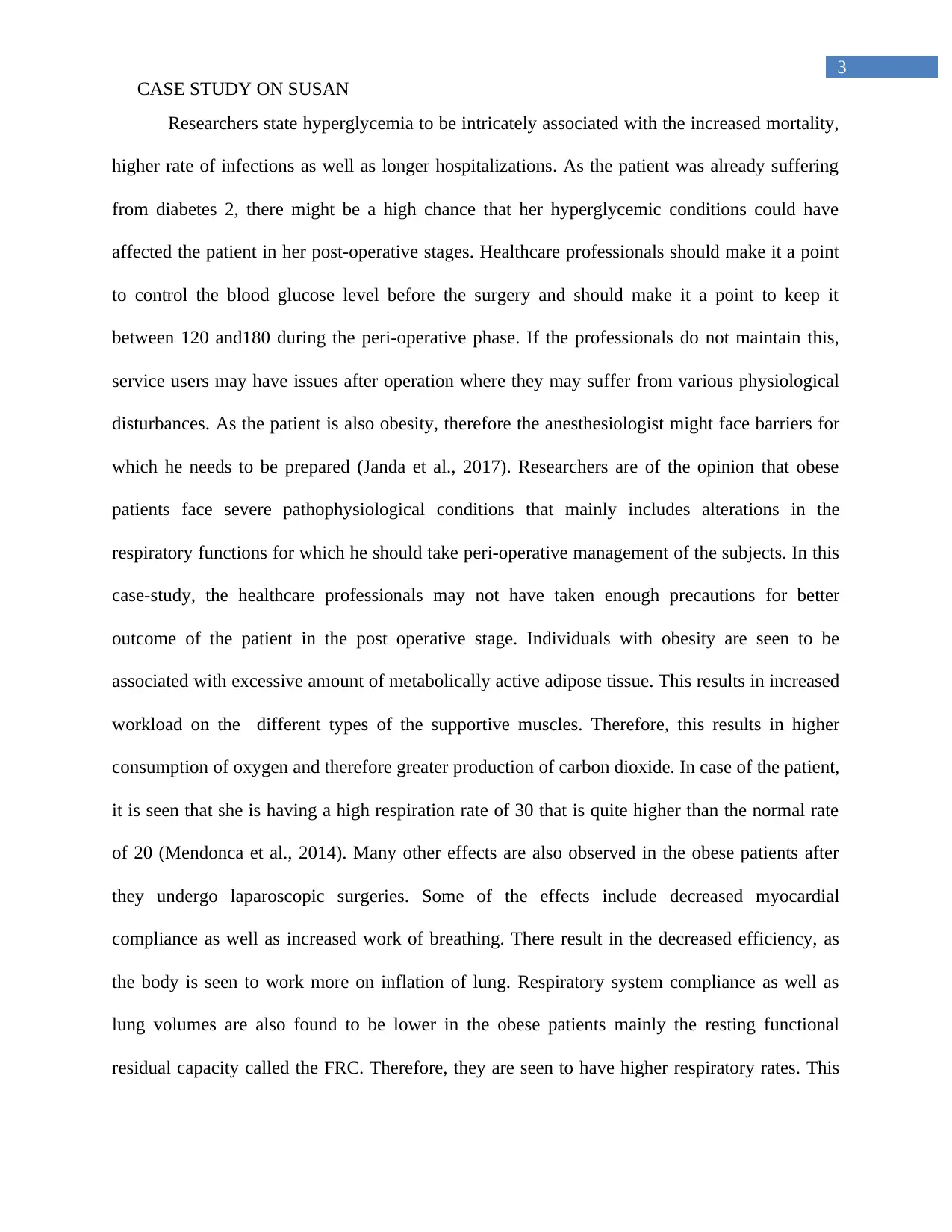
3
CASE STUDY ON SUSAN
Researchers state hyperglycemia to be intricately associated with the increased mortality,
higher rate of infections as well as longer hospitalizations. As the patient was already suffering
from diabetes 2, there might be a high chance that her hyperglycemic conditions could have
affected the patient in her post-operative stages. Healthcare professionals should make it a point
to control the blood glucose level before the surgery and should make it a point to keep it
between 120 and180 during the peri-operative phase. If the professionals do not maintain this,
service users may have issues after operation where they may suffer from various physiological
disturbances. As the patient is also obesity, therefore the anesthesiologist might face barriers for
which he needs to be prepared (Janda et al., 2017). Researchers are of the opinion that obese
patients face severe pathophysiological conditions that mainly includes alterations in the
respiratory functions for which he should take peri-operative management of the subjects. In this
case-study, the healthcare professionals may not have taken enough precautions for better
outcome of the patient in the post operative stage. Individuals with obesity are seen to be
associated with excessive amount of metabolically active adipose tissue. This results in increased
workload on the different types of the supportive muscles. Therefore, this results in higher
consumption of oxygen and therefore greater production of carbon dioxide. In case of the patient,
it is seen that she is having a high respiration rate of 30 that is quite higher than the normal rate
of 20 (Mendonca et al., 2014). Many other effects are also observed in the obese patients after
they undergo laparoscopic surgeries. Some of the effects include decreased myocardial
compliance as well as increased work of breathing. There result in the decreased efficiency, as
the body is seen to work more on inflation of lung. Respiratory system compliance as well as
lung volumes are also found to be lower in the obese patients mainly the resting functional
residual capacity called the FRC. Therefore, they are seen to have higher respiratory rates. This
CASE STUDY ON SUSAN
Researchers state hyperglycemia to be intricately associated with the increased mortality,
higher rate of infections as well as longer hospitalizations. As the patient was already suffering
from diabetes 2, there might be a high chance that her hyperglycemic conditions could have
affected the patient in her post-operative stages. Healthcare professionals should make it a point
to control the blood glucose level before the surgery and should make it a point to keep it
between 120 and180 during the peri-operative phase. If the professionals do not maintain this,
service users may have issues after operation where they may suffer from various physiological
disturbances. As the patient is also obesity, therefore the anesthesiologist might face barriers for
which he needs to be prepared (Janda et al., 2017). Researchers are of the opinion that obese
patients face severe pathophysiological conditions that mainly includes alterations in the
respiratory functions for which he should take peri-operative management of the subjects. In this
case-study, the healthcare professionals may not have taken enough precautions for better
outcome of the patient in the post operative stage. Individuals with obesity are seen to be
associated with excessive amount of metabolically active adipose tissue. This results in increased
workload on the different types of the supportive muscles. Therefore, this results in higher
consumption of oxygen and therefore greater production of carbon dioxide. In case of the patient,
it is seen that she is having a high respiration rate of 30 that is quite higher than the normal rate
of 20 (Mendonca et al., 2014). Many other effects are also observed in the obese patients after
they undergo laparoscopic surgeries. Some of the effects include decreased myocardial
compliance as well as increased work of breathing. There result in the decreased efficiency, as
the body is seen to work more on inflation of lung. Respiratory system compliance as well as
lung volumes are also found to be lower in the obese patients mainly the resting functional
residual capacity called the FRC. Therefore, they are seen to have higher respiratory rates. This
Secure Best Marks with AI Grader
Need help grading? Try our AI Grader for instant feedback on your assignments.
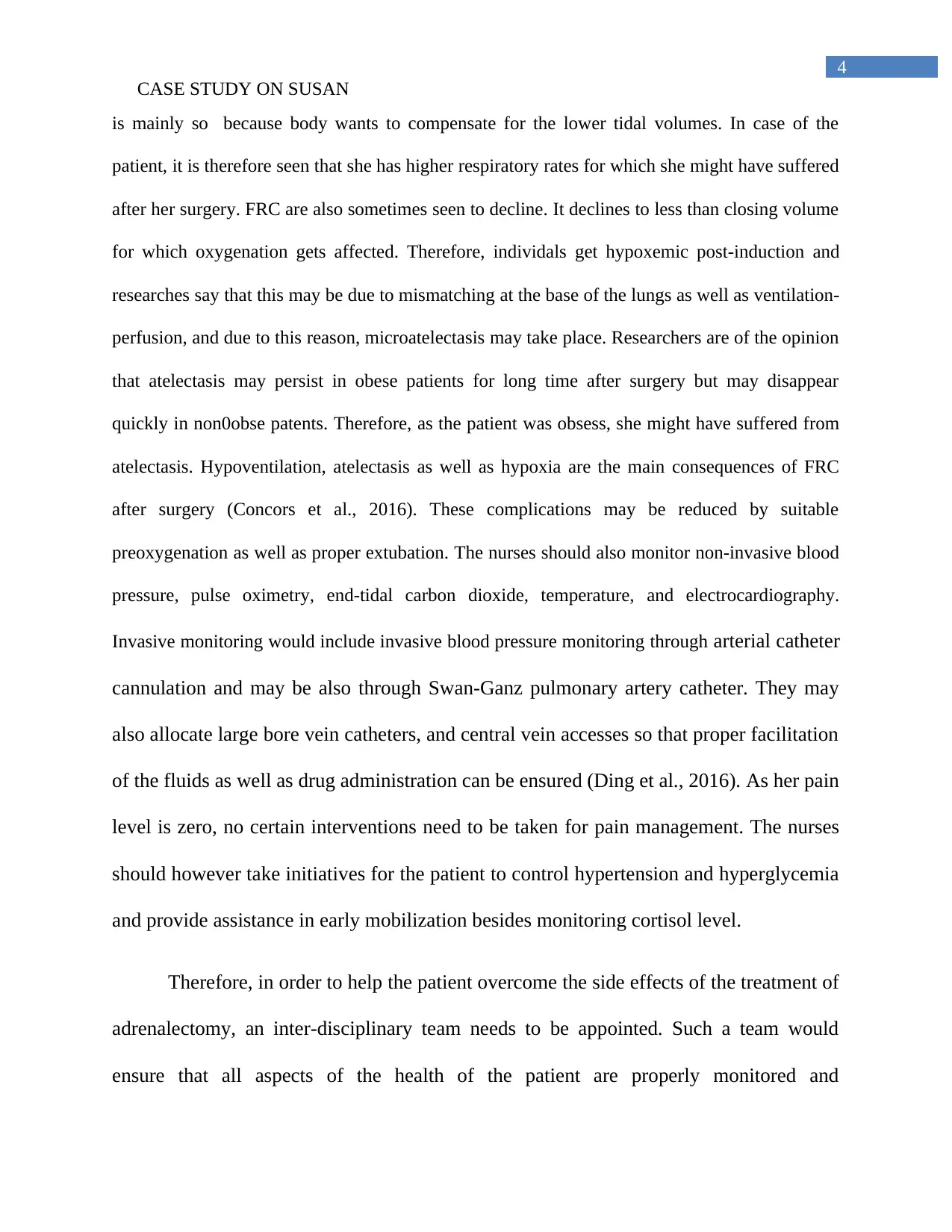
4
CASE STUDY ON SUSAN
is mainly so because body wants to compensate for the lower tidal volumes. In case of the
patient, it is therefore seen that she has higher respiratory rates for which she might have suffered
after her surgery. FRC are also sometimes seen to decline. It declines to less than closing volume
for which oxygenation gets affected. Therefore, individals get hypoxemic post-induction and
researches say that this may be due to mismatching at the base of the lungs as well as ventilation-
perfusion, and due to this reason, microatelectasis may take place. Researchers are of the opinion
that atelectasis may persist in obese patients for long time after surgery but may disappear
quickly in non0obse patents. Therefore, as the patient was obsess, she might have suffered from
atelectasis. Hypoventilation, atelectasis as well as hypoxia are the main consequences of FRC
after surgery (Concors et al., 2016). These complications may be reduced by suitable
preoxygenation as well as proper extubation. The nurses should also monitor non-invasive blood
pressure, pulse oximetry, end-tidal carbon dioxide, temperature, and electrocardiography.
Invasive monitoring would include invasive blood pressure monitoring through arterial catheter
cannulation and may be also through Swan-Ganz pulmonary artery catheter. They may
also allocate large bore vein catheters, and central vein accesses so that proper facilitation
of the fluids as well as drug administration can be ensured (Ding et al., 2016). As her pain
level is zero, no certain interventions need to be taken for pain management. The nurses
should however take initiatives for the patient to control hypertension and hyperglycemia
and provide assistance in early mobilization besides monitoring cortisol level.
Therefore, in order to help the patient overcome the side effects of the treatment of
adrenalectomy, an inter-disciplinary team needs to be appointed. Such a team would
ensure that all aspects of the health of the patient are properly monitored and
CASE STUDY ON SUSAN
is mainly so because body wants to compensate for the lower tidal volumes. In case of the
patient, it is therefore seen that she has higher respiratory rates for which she might have suffered
after her surgery. FRC are also sometimes seen to decline. It declines to less than closing volume
for which oxygenation gets affected. Therefore, individals get hypoxemic post-induction and
researches say that this may be due to mismatching at the base of the lungs as well as ventilation-
perfusion, and due to this reason, microatelectasis may take place. Researchers are of the opinion
that atelectasis may persist in obese patients for long time after surgery but may disappear
quickly in non0obse patents. Therefore, as the patient was obsess, she might have suffered from
atelectasis. Hypoventilation, atelectasis as well as hypoxia are the main consequences of FRC
after surgery (Concors et al., 2016). These complications may be reduced by suitable
preoxygenation as well as proper extubation. The nurses should also monitor non-invasive blood
pressure, pulse oximetry, end-tidal carbon dioxide, temperature, and electrocardiography.
Invasive monitoring would include invasive blood pressure monitoring through arterial catheter
cannulation and may be also through Swan-Ganz pulmonary artery catheter. They may
also allocate large bore vein catheters, and central vein accesses so that proper facilitation
of the fluids as well as drug administration can be ensured (Ding et al., 2016). As her pain
level is zero, no certain interventions need to be taken for pain management. The nurses
should however take initiatives for the patient to control hypertension and hyperglycemia
and provide assistance in early mobilization besides monitoring cortisol level.
Therefore, in order to help the patient overcome the side effects of the treatment of
adrenalectomy, an inter-disciplinary team needs to be appointed. Such a team would
ensure that all aspects of the health of the patient are properly monitored and
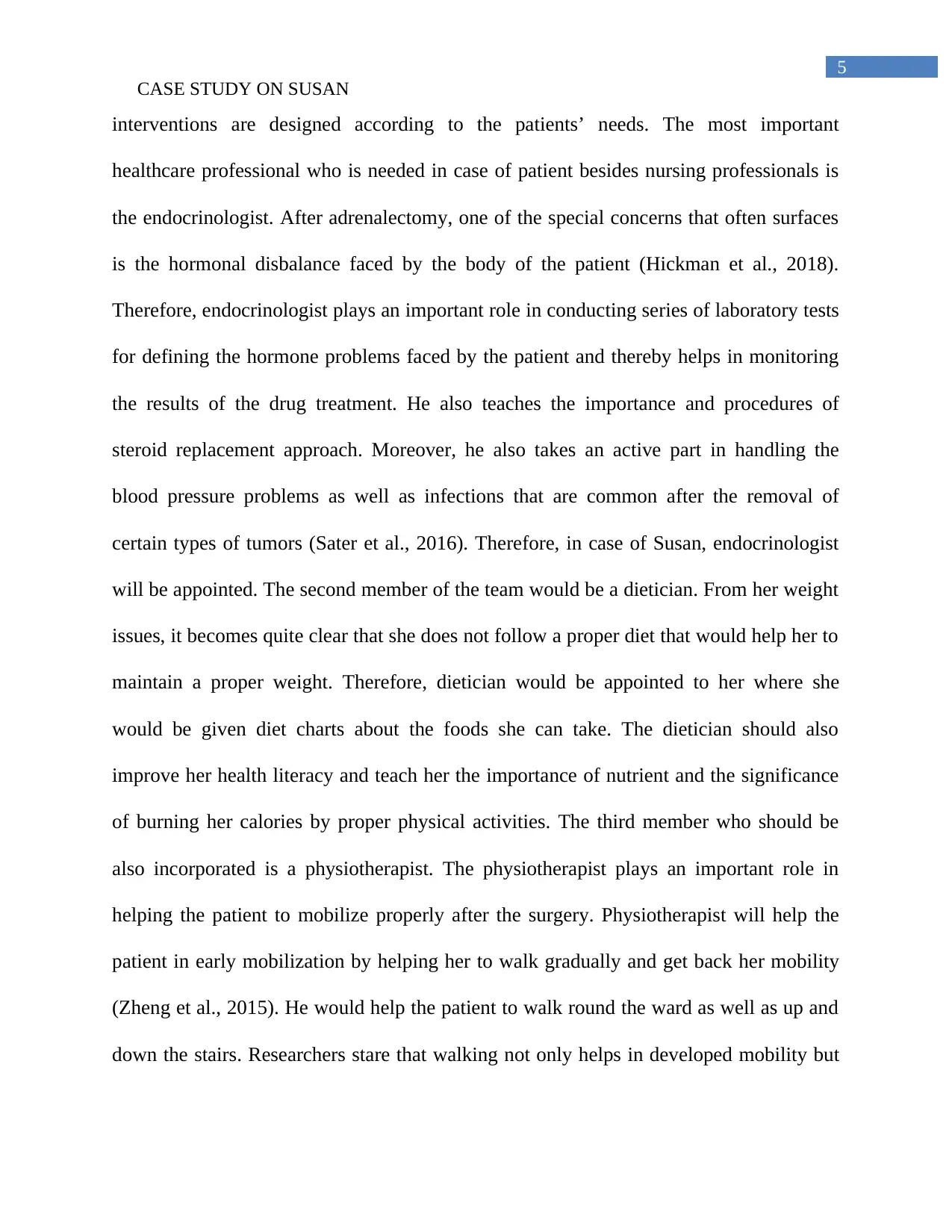
5
CASE STUDY ON SUSAN
interventions are designed according to the patients’ needs. The most important
healthcare professional who is needed in case of patient besides nursing professionals is
the endocrinologist. After adrenalectomy, one of the special concerns that often surfaces
is the hormonal disbalance faced by the body of the patient (Hickman et al., 2018).
Therefore, endocrinologist plays an important role in conducting series of laboratory tests
for defining the hormone problems faced by the patient and thereby helps in monitoring
the results of the drug treatment. He also teaches the importance and procedures of
steroid replacement approach. Moreover, he also takes an active part in handling the
blood pressure problems as well as infections that are common after the removal of
certain types of tumors (Sater et al., 2016). Therefore, in case of Susan, endocrinologist
will be appointed. The second member of the team would be a dietician. From her weight
issues, it becomes quite clear that she does not follow a proper diet that would help her to
maintain a proper weight. Therefore, dietician would be appointed to her where she
would be given diet charts about the foods she can take. The dietician should also
improve her health literacy and teach her the importance of nutrient and the significance
of burning her calories by proper physical activities. The third member who should be
also incorporated is a physiotherapist. The physiotherapist plays an important role in
helping the patient to mobilize properly after the surgery. Physiotherapist will help the
patient in early mobilization by helping her to walk gradually and get back her mobility
(Zheng et al., 2015). He would help the patient to walk round the ward as well as up and
down the stairs. Researchers stare that walking not only helps in developed mobility but
CASE STUDY ON SUSAN
interventions are designed according to the patients’ needs. The most important
healthcare professional who is needed in case of patient besides nursing professionals is
the endocrinologist. After adrenalectomy, one of the special concerns that often surfaces
is the hormonal disbalance faced by the body of the patient (Hickman et al., 2018).
Therefore, endocrinologist plays an important role in conducting series of laboratory tests
for defining the hormone problems faced by the patient and thereby helps in monitoring
the results of the drug treatment. He also teaches the importance and procedures of
steroid replacement approach. Moreover, he also takes an active part in handling the
blood pressure problems as well as infections that are common after the removal of
certain types of tumors (Sater et al., 2016). Therefore, in case of Susan, endocrinologist
will be appointed. The second member of the team would be a dietician. From her weight
issues, it becomes quite clear that she does not follow a proper diet that would help her to
maintain a proper weight. Therefore, dietician would be appointed to her where she
would be given diet charts about the foods she can take. The dietician should also
improve her health literacy and teach her the importance of nutrient and the significance
of burning her calories by proper physical activities. The third member who should be
also incorporated is a physiotherapist. The physiotherapist plays an important role in
helping the patient to mobilize properly after the surgery. Physiotherapist will help the
patient in early mobilization by helping her to walk gradually and get back her mobility
(Zheng et al., 2015). He would help the patient to walk round the ward as well as up and
down the stairs. Researchers stare that walking not only helps in developed mobility but

6
CASE STUDY ON SUSAN
also ensures blood circulation, bowel movement as well as helps in making the breathing
get back to normal (Rosato et al., 2016).
From the entire case study, it becomes quite clear that tumor on the adrenal
gland is resulting in the increase of cortisol throughout the body resulting in Cushing
syndrome in the patient named Susan. Therefore, she is suffering from primary
hypercortisolism for which surgery was done to remove her right adrenal gland.
Postoperative issues comprised of increased respiratory rate mainly due to reduced
functional residual capacity. Therefore, interventions should be taken by nurses to help
the patient get back to normal breathing procedures. The healthcare team should
comprise of endocrinologist, dietician and physiotherapist besides nurses to attend to the
needs of the patient effectively.
CASE STUDY ON SUSAN
also ensures blood circulation, bowel movement as well as helps in making the breathing
get back to normal (Rosato et al., 2016).
From the entire case study, it becomes quite clear that tumor on the adrenal
gland is resulting in the increase of cortisol throughout the body resulting in Cushing
syndrome in the patient named Susan. Therefore, she is suffering from primary
hypercortisolism for which surgery was done to remove her right adrenal gland.
Postoperative issues comprised of increased respiratory rate mainly due to reduced
functional residual capacity. Therefore, interventions should be taken by nurses to help
the patient get back to normal breathing procedures. The healthcare team should
comprise of endocrinologist, dietician and physiotherapist besides nurses to attend to the
needs of the patient effectively.
Paraphrase This Document
Need a fresh take? Get an instant paraphrase of this document with our AI Paraphraser
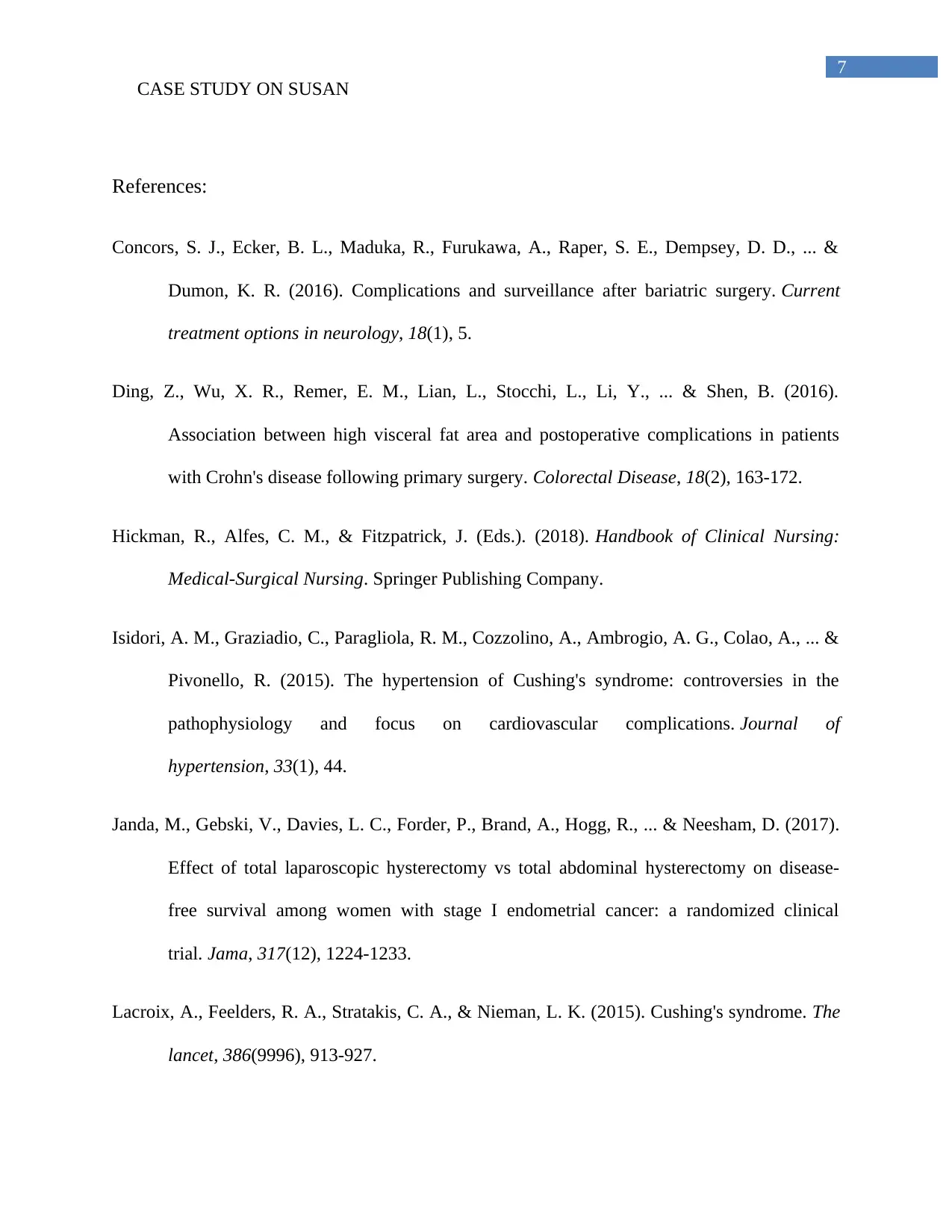
7
CASE STUDY ON SUSAN
References:
Concors, S. J., Ecker, B. L., Maduka, R., Furukawa, A., Raper, S. E., Dempsey, D. D., ... &
Dumon, K. R. (2016). Complications and surveillance after bariatric surgery. Current
treatment options in neurology, 18(1), 5.
Ding, Z., Wu, X. R., Remer, E. M., Lian, L., Stocchi, L., Li, Y., ... & Shen, B. (2016).
Association between high visceral fat area and postoperative complications in patients
with Crohn's disease following primary surgery. Colorectal Disease, 18(2), 163-172.
Hickman, R., Alfes, C. M., & Fitzpatrick, J. (Eds.). (2018). Handbook of Clinical Nursing:
Medical-Surgical Nursing. Springer Publishing Company.
Isidori, A. M., Graziadio, C., Paragliola, R. M., Cozzolino, A., Ambrogio, A. G., Colao, A., ... &
Pivonello, R. (2015). The hypertension of Cushing's syndrome: controversies in the
pathophysiology and focus on cardiovascular complications. Journal of
hypertension, 33(1), 44.
Janda, M., Gebski, V., Davies, L. C., Forder, P., Brand, A., Hogg, R., ... & Neesham, D. (2017).
Effect of total laparoscopic hysterectomy vs total abdominal hysterectomy on disease-
free survival among women with stage I endometrial cancer: a randomized clinical
trial. Jama, 317(12), 1224-1233.
Lacroix, A., Feelders, R. A., Stratakis, C. A., & Nieman, L. K. (2015). Cushing's syndrome. The
lancet, 386(9996), 913-927.
CASE STUDY ON SUSAN
References:
Concors, S. J., Ecker, B. L., Maduka, R., Furukawa, A., Raper, S. E., Dempsey, D. D., ... &
Dumon, K. R. (2016). Complications and surveillance after bariatric surgery. Current
treatment options in neurology, 18(1), 5.
Ding, Z., Wu, X. R., Remer, E. M., Lian, L., Stocchi, L., Li, Y., ... & Shen, B. (2016).
Association between high visceral fat area and postoperative complications in patients
with Crohn's disease following primary surgery. Colorectal Disease, 18(2), 163-172.
Hickman, R., Alfes, C. M., & Fitzpatrick, J. (Eds.). (2018). Handbook of Clinical Nursing:
Medical-Surgical Nursing. Springer Publishing Company.
Isidori, A. M., Graziadio, C., Paragliola, R. M., Cozzolino, A., Ambrogio, A. G., Colao, A., ... &
Pivonello, R. (2015). The hypertension of Cushing's syndrome: controversies in the
pathophysiology and focus on cardiovascular complications. Journal of
hypertension, 33(1), 44.
Janda, M., Gebski, V., Davies, L. C., Forder, P., Brand, A., Hogg, R., ... & Neesham, D. (2017).
Effect of total laparoscopic hysterectomy vs total abdominal hysterectomy on disease-
free survival among women with stage I endometrial cancer: a randomized clinical
trial. Jama, 317(12), 1224-1233.
Lacroix, A., Feelders, R. A., Stratakis, C. A., & Nieman, L. K. (2015). Cushing's syndrome. The
lancet, 386(9996), 913-927.
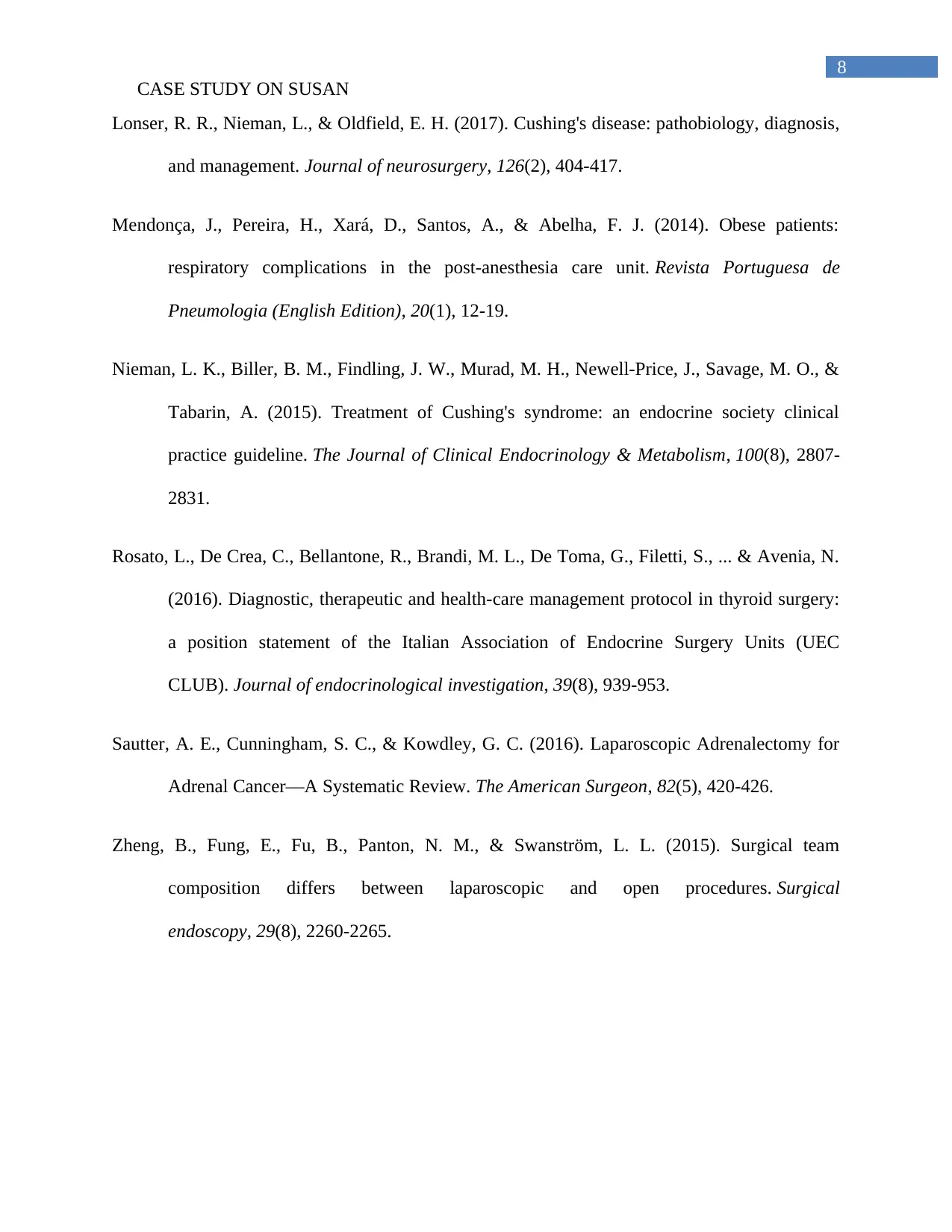
8
CASE STUDY ON SUSAN
Lonser, R. R., Nieman, L., & Oldfield, E. H. (2017). Cushing's disease: pathobiology, diagnosis,
and management. Journal of neurosurgery, 126(2), 404-417.
Mendonça, J., Pereira, H., Xará, D., Santos, A., & Abelha, F. J. (2014). Obese patients:
respiratory complications in the post-anesthesia care unit. Revista Portuguesa de
Pneumologia (English Edition), 20(1), 12-19.
Nieman, L. K., Biller, B. M., Findling, J. W., Murad, M. H., Newell-Price, J., Savage, M. O., &
Tabarin, A. (2015). Treatment of Cushing's syndrome: an endocrine society clinical
practice guideline. The Journal of Clinical Endocrinology & Metabolism, 100(8), 2807-
2831.
Rosato, L., De Crea, C., Bellantone, R., Brandi, M. L., De Toma, G., Filetti, S., ... & Avenia, N.
(2016). Diagnostic, therapeutic and health-care management protocol in thyroid surgery:
a position statement of the Italian Association of Endocrine Surgery Units (UEC
CLUB). Journal of endocrinological investigation, 39(8), 939-953.
Sautter, A. E., Cunningham, S. C., & Kowdley, G. C. (2016). Laparoscopic Adrenalectomy for
Adrenal Cancer—A Systematic Review. The American Surgeon, 82(5), 420-426.
Zheng, B., Fung, E., Fu, B., Panton, N. M., & Swanström, L. L. (2015). Surgical team
composition differs between laparoscopic and open procedures. Surgical
endoscopy, 29(8), 2260-2265.
CASE STUDY ON SUSAN
Lonser, R. R., Nieman, L., & Oldfield, E. H. (2017). Cushing's disease: pathobiology, diagnosis,
and management. Journal of neurosurgery, 126(2), 404-417.
Mendonça, J., Pereira, H., Xará, D., Santos, A., & Abelha, F. J. (2014). Obese patients:
respiratory complications in the post-anesthesia care unit. Revista Portuguesa de
Pneumologia (English Edition), 20(1), 12-19.
Nieman, L. K., Biller, B. M., Findling, J. W., Murad, M. H., Newell-Price, J., Savage, M. O., &
Tabarin, A. (2015). Treatment of Cushing's syndrome: an endocrine society clinical
practice guideline. The Journal of Clinical Endocrinology & Metabolism, 100(8), 2807-
2831.
Rosato, L., De Crea, C., Bellantone, R., Brandi, M. L., De Toma, G., Filetti, S., ... & Avenia, N.
(2016). Diagnostic, therapeutic and health-care management protocol in thyroid surgery:
a position statement of the Italian Association of Endocrine Surgery Units (UEC
CLUB). Journal of endocrinological investigation, 39(8), 939-953.
Sautter, A. E., Cunningham, S. C., & Kowdley, G. C. (2016). Laparoscopic Adrenalectomy for
Adrenal Cancer—A Systematic Review. The American Surgeon, 82(5), 420-426.
Zheng, B., Fung, E., Fu, B., Panton, N. M., & Swanström, L. L. (2015). Surgical team
composition differs between laparoscopic and open procedures. Surgical
endoscopy, 29(8), 2260-2265.
1 out of 9
Related Documents
Your All-in-One AI-Powered Toolkit for Academic Success.
+13062052269
info@desklib.com
Available 24*7 on WhatsApp / Email
![[object Object]](/_next/static/media/star-bottom.7253800d.svg)
Unlock your academic potential
© 2024 | Zucol Services PVT LTD | All rights reserved.





